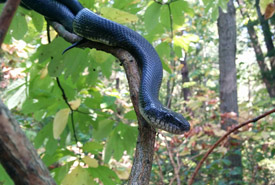
Gray ratsnake (Photo by Jessica Ferguson)
Gray ratsnake
What does it look like?
Native to North America, the non-venomous gray ratsnake is the largest snake in Canada, reaching approximately 190 centimetres in length. It has a slender body with keeled scales (scales with ridges running through the centre), a white belly and a cream or white throat.
The colour of its back varies with age; juveniles are a pale grey with patterned dark grey or brown marks on its tail and body. Adults are largely black. Sometimes, faint traces of patterns remain on adults.
Where does it live?
The species has a small home range — in Ontario — with two recognized sub-populations: Carolinian and Great Lakes/St. Lawrence populations.
Although it can be found across a wide range of woodland habitats, the gray ratsnake prefers edge habitats, where forests and open habitats (fields, marshes or rocky outcrops) meet.
During the winter, the species inhabits underground hibernacula (shelter where snakes sleep in the winter). A good hibernacula protects it from freezing and drying out.
What is this species' conservation status?
The Committee on the Status of Endangered Wildlife in Canada has assessed the Carolinian population as endangered, and the Great Lakes/St. Lawrence population as threatened.
Increased development in key habitat areas has led to habitat fragmentation and degradation, threatening its survival. Snakes are also at risk from being run over by vehicles.
What is NCC doing to conserve habitat for this species?
The Nature Conservancy of Canada (NCC) conserves known and suspected gray ratsnake habitat, including in the Frontenac Arch Natural Area and the Carolinian forest region.
NCC is also supporting researchers studying gray ratsnake in the Carolinian forest region. Researchers are investigating the hibernation and movement ecology of this population, and they have helped identify key movement corridors and hibernacula. This information will help inform NCC’s stewardship of these natural areas to support local gray ratsnake populations.





